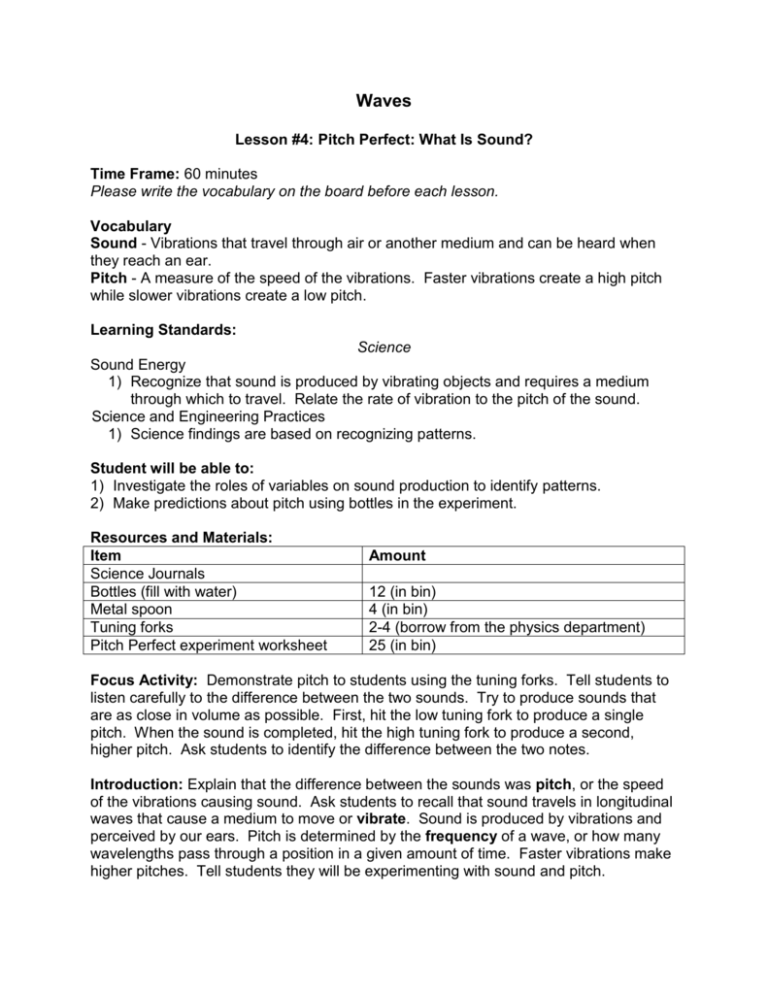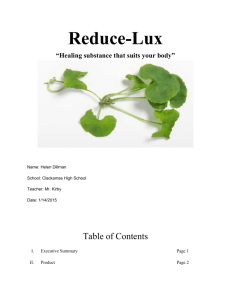Lesson #4: Pitch Perfect: What is Sound?
advertisement

Waves Lesson #4: Pitch Perfect: What Is Sound? Time Frame: 60 minutes Please write the vocabulary on the board before each lesson. Vocabulary Sound - Vibrations that travel through air or another medium and can be heard when they reach an ear. Pitch - A measure of the speed of the vibrations. Faster vibrations create a high pitch while slower vibrations create a low pitch. Learning Standards: Science Sound Energy 1) Recognize that sound is produced by vibrating objects and requires a medium through which to travel. Relate the rate of vibration to the pitch of the sound. Science and Engineering Practices 1) Science findings are based on recognizing patterns. Student will be able to: 1) Investigate the roles of variables on sound production to identify patterns. 2) Make predictions about pitch using bottles in the experiment. Resources and Materials: Item Science Journals Bottles (fill with water) Metal spoon Tuning forks Pitch Perfect experiment worksheet Amount 12 (in bin) 4 (in bin) 2-4 (borrow from the physics department) 25 (in bin) Focus Activity: Demonstrate pitch to students using the tuning forks. Tell students to listen carefully to the difference between the two sounds. Try to produce sounds that are as close in volume as possible. First, hit the low tuning fork to produce a single pitch. When the sound is completed, hit the high tuning fork to produce a second, higher pitch. Ask students to identify the difference between the two notes. Introduction: Explain that the difference between the sounds was pitch, or the speed of the vibrations causing sound. Ask students to recall that sound travels in longitudinal waves that cause a medium to move or vibrate. Sound is produced by vibrations and perceived by our ears. Pitch is determined by the frequency of a wave, or how many wavelengths pass through a position in a given amount of time. Faster vibrations make higher pitches. Tell students they will be experimenting with sound and pitch. Activity: 1) Split the class into four groups. Each group should have 3 bottles (1 full bottle, 1 half-full bottle, and 1 empty bottle) and 1 metal spoon. Each student should have their own experiment sheet. Scientists’ hypotheses are based on their previous knowledge and can be tested. Before the experiments, students should make hypotheses about what will happen in each part of the experiment. Give examples of good and bad hypotheses as a refresher. (For example, this would be a good hypothesis: "I predict that the pitch of the full bottle will be higher than the pitch of the empty bottle because it has more water in it." This would be a bad hypothesis: "nothing will happen.") 2) Test #1- Full vs. Empty Bottles a) Use 1 full bottle and 1 empty bottle. Have students clink each bottle with a metal spoon and answer the questions about sound and pitch on their experiment sheet. 3) Test #2- Glass Is Half Full a) Use 1 full bottle, 1 half full bottle, and 1 empty bottle. b) Before clinking the bottles, each student must make a prediction about pitch on the provided worksheet. c) Have students clink the bottles with a metal spoon and answer the question about the half-full bottle. Teacher Explanation for Test #1 and Test #2: Sound comes from vibrations. When you hit the bottle with a spoon, it makes the glass vibrate. When you fill the bottle with water, the glass cannot vibrate as quickly, because water slows or dampens the vibrations. Fast vibrations make a high sound and slow vibrations make a low sound. A full bottle will produce a slow vibration and a low sound. An empty bottle will produce a faster vibration and a higher sound. 4) Test #3- Blow Your Top a) Use 1 full bottle, 1 half full bottle, and 1 empty bottle. b) Make a hypothesis about what will happen if you blow across the top of the bottles instead of clinking the side with a metal spoon. Will the pitch change? c) Blow air across the bottles. Students should NOT put their mouths on the bottles. d) Write your observations. Was your hypothesis correct? Why or why not? Teacher Explanation for Test #3: Clinking the bottle and blowing in it do not produce the same sound. Blowing into the bottle makes the air in the bottle vibrate while hitting the glass makes the glass vibrate. When you blow across the top of the bottle, a wave of compressed air travels down into the inside of the bottle. It strikes the surface of the water and is reflected back up towards the opening. The waves travel faster inside bottles with less water. This causes the air to vibrate more slowly, resulting in the opposite effect of hitting the bottle. Closure: In our experiments with bottles, we changed variables to see what effects they had on pitch. Variables are the parts of the experiment that change – the amount of water in a bottle (full, half-full, empty) or the tools used to make sound waves (spoon, breath). What is another variable you could change about the experiment to explore differences in pitch? Assessment: Pitch Perfect experiment sheet, participation in the experiment and class discussions. Waves Lesson #4: Pitch Perfect Experiment Sheet Name________________________________________________ Date___________________________ When you blow air across the top of the bottle or tap a soda bottle with a metal spoon, the bottle makes a noise. Sometimes the sound is high and sometimes the sound is low. We want to find out how the liquid in the bottle makes the sound change. Make a Hypothesis! What kind of sound, high or low, do you think the bottle make when it is full of water? What about when it has no water in it? ______________________________________________________________________ ______________________________________________________________________ ______________________________________________________________________ Will blowing into the bottle produce the same sound as tapping it with a metal spoon? ______________________________________________________________________ ______________________________________________________________________ Test #1: You need two bottles for this experiment. Fill one bottle full with water and leave the other bottle empty. Gently tap both bottles with the metal spoon and observe the pitch produced by each bottle. Do the bottles sound different? ______________________________________________________________________ Which one has a higher pitch, the empty bottle or the full one? ______________________________________________________________________ PREDICT What pitch will a half-full bottle produce? Will it be higher or lower than a full bottle? ______________________________________________________________________ ______________________________________________________________________ ______________________________________________________________________ Test #2: You need three bottles for this experiment. Fill the first bottle full of water. Fill the second bottle half-full. Don’t put water in the third bottle. Gently tap both bottles with the metal spoon and observe each pitch. Was your hypothesis correct? How was the pitch of the half-full bottle different than the full bottle and the empty bottle? ______________________________________________________________________ ______________________________________________________________________ ______________________________________________________________________ Test #3: This experiment will use the same three bottles as Test #2, the full bottle, the halffull bottle, and the empty bottle. Instead of tapping each bottle with a spoon, blow air across the top of the bottle. Be careful not to put your mouth on the bottle! Refer to the front of your experiment sheet. Was your hypothesis about blowing air across the bottle correct? How is the sound produced by blowing air different than the sound produced by tapping glass? ______________________________________________________________________ ______________________________________________________________________ ______________________________________________________________________







